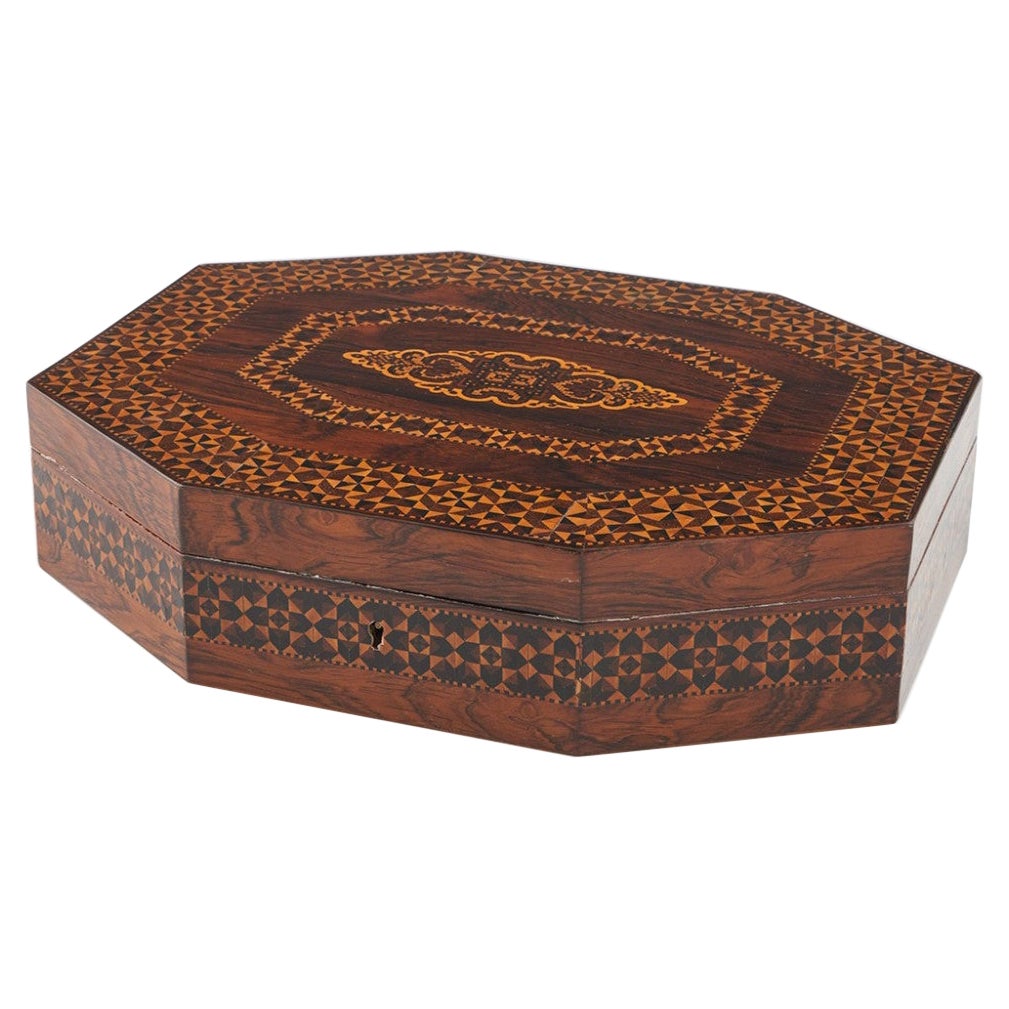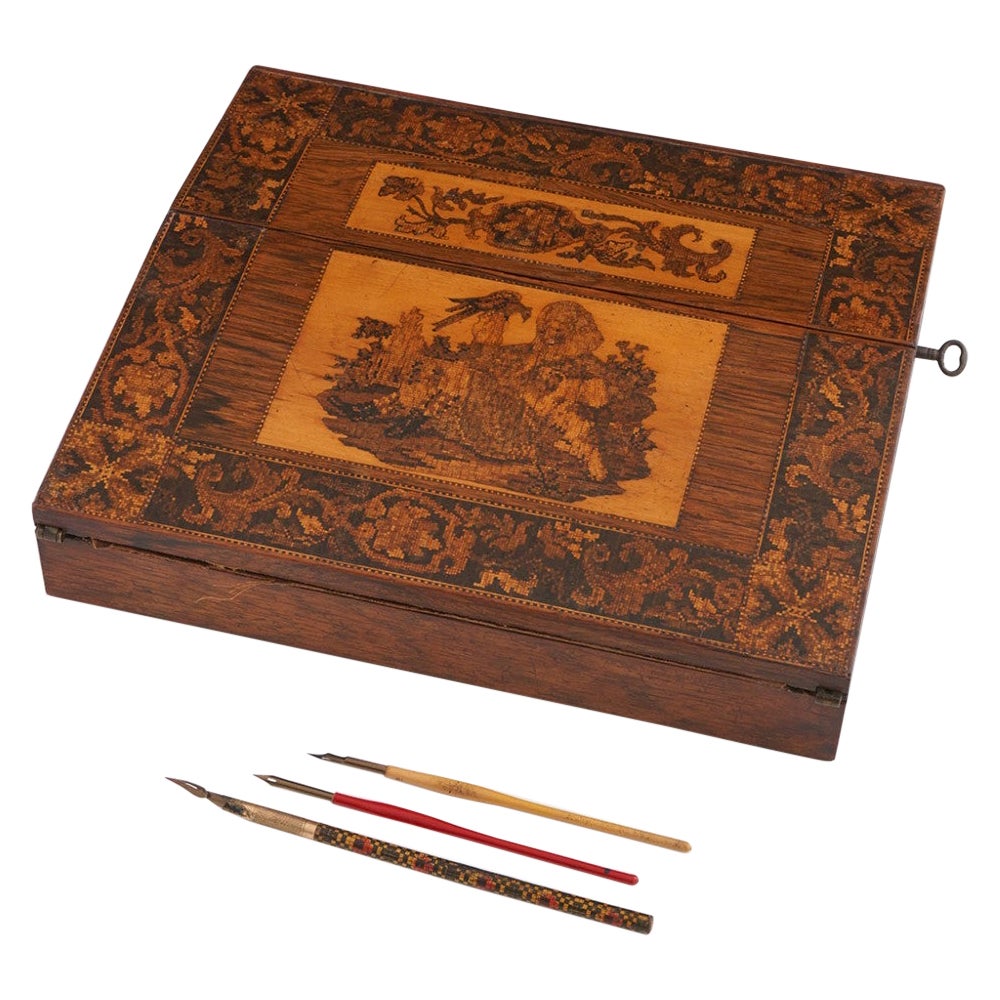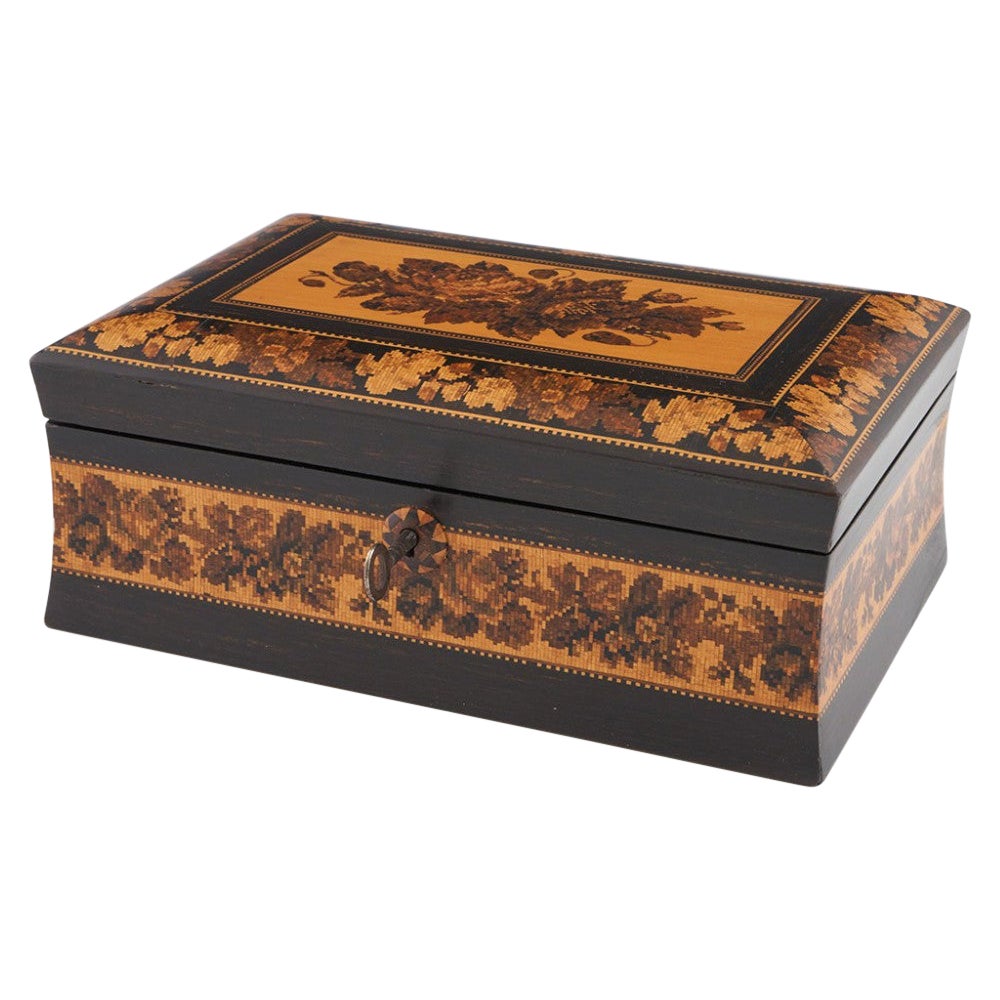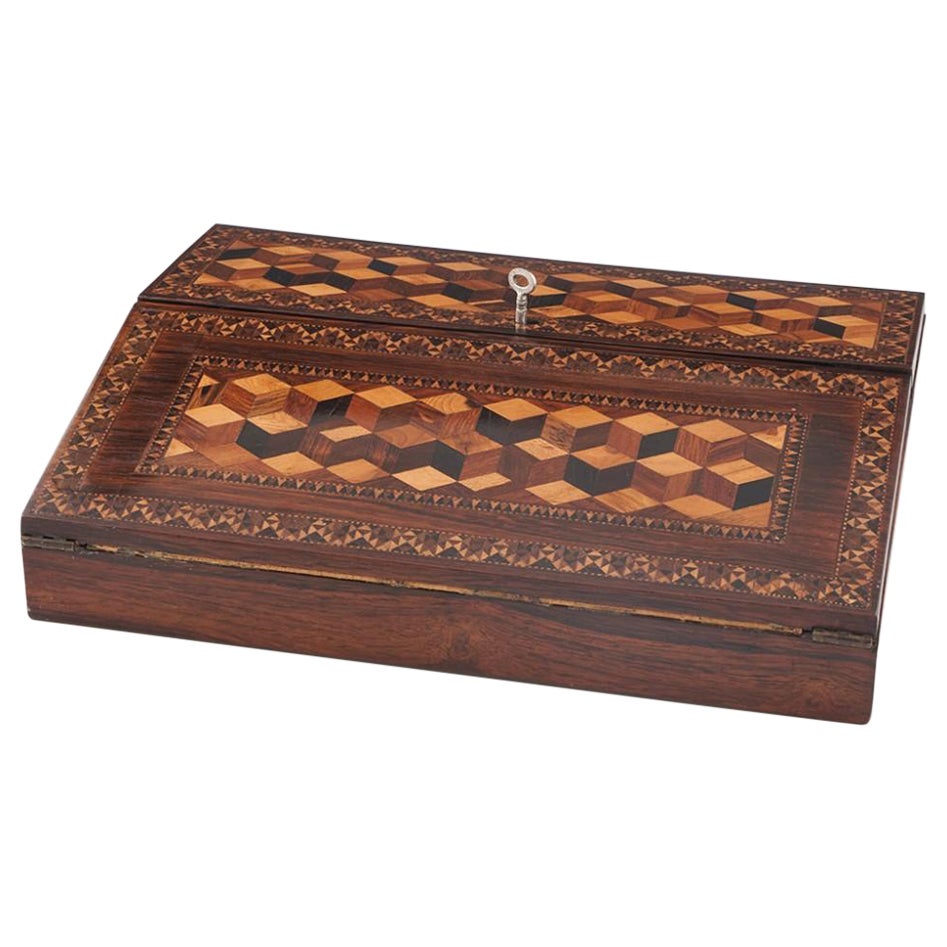Items Similar to Tunbridge Ware Jewellery Box Featuring Eridge Castle c1850
Want more images or videos?
Request additional images or videos from the seller
1 of 11
Tunbridge Ware Jewellery Box Featuring Eridge Castle c1850
About the Item
Heading : Tunbridge ware jewellery box
Date : c1850
Period : Victoria
Origin : Tunbridge Wells, Kent
Decoration : Central image of Eridge Castle within keylines. Geometric border also within keylines. Berlin woolwork floral frieze to the side panels. Internally there is a lift-away tray with ring holders, this is velvet lined with polychrome parquetry border, the rest of the interior is velvet lined with a little paper lining to the edges.
Size : 20.5x12.8x6.5cm
Condition : Good, a little cracking to the cover, a few missing tesserae to the border, otherwise just minor scratches and wear
Restoration : A chip has been repaired to the back right corner of the lid
Weight : 426 grams
Eridge Castle was a particularly popular image on Tunbridge ware, unsurprising when one considers it was the nearest stately home to the manufacturers. This version of the castle was first produced by Humphrey Burrows the elder in 1844.
- Creator:Tunbridge Ware (Maker)
- Dimensions:Height: 6.5 in (16.51 cm)Width: 12.8 in (32.52 cm)Depth: 20.5 in (52.07 cm)
- Style:Victorian (Of the Period)
- Materials and Techniques:
- Place of Origin:
- Period:
- Date of Manufacture:1850
- Condition:Wear consistent with age and use.
- Seller Location:Tunbridge Wells, GB
- Reference Number:
About the Seller
5.0
Gold Seller
These expertly vetted sellers are highly rated and consistently exceed customer expectations.
Established in 2014
1stDibs seller since 2023
33 sales on 1stDibs
Typical response time: 6 hours
- ShippingRetrieving quote...Ships From: Tunbridge Wells, United Kingdom
- Return PolicyA return for this item may be initiated within 30 days of delivery.
More From This SellerView All
- Tunbridge Ware Workbox c1850By Tunbridge WareLocated in Tunbridge Wells, GBHeading : Tunbridge ware work box Date : c1850 Period : Victoria Origin : Tunbridge Wells, Kent . Almost certainly early Edmund Nye or George Burrows. Decoration : Central stylised f...Category
Antique 1850s British Victorian Jewelry Boxes
MaterialsWood
- Tunbridge Ware Writing Slope c1850By Tunbridge WareLocated in Tunbridge Wells, GBHeading : Tunbridge ware writing slope Date : c1875 Period : Victoria Origin : Tunbridge Wells, kent Decoration : Central mosaic of a child with small dog and bird. Above is a foliat...Category
Antique 1850s British Victorian Decorative Boxes
MaterialsWood
- Tunbridge Ware Jewellery Box c1870By Tunbridge WareLocated in Tunbridge Wells, GBHeading : Tunbridge ware jewellery box Date : c1870 Period : Victoria Origin : Tunbridge Wells, Kent Decoration : Pillow top cover with central floral mosaic within keylines. Cover b...Category
Antique 1870s British Victorian Decorative Boxes
MaterialsWood
- Robert Vorley Tunbridge Ware Jewellery Box 2022By Tunbridge WareLocated in Tunbridge Wells, GBHeading : Robert Vorley Tunbridge ware box Date : 2022 Period : Elizabeth II Origin : Essex Decoration : Central tesselated Painted Lady butterfly w...Category
2010s British Victorian Jewelry Boxes
MaterialsWood
- Eridge Castle Tunbridge Ware Tea Caddy c1860By Henry HollambyLocated in Tunbridge Wells, GBHeading : Two compartment Tunbridge ware tea caddy Date : c1860 Period : Victoria Origin : Tunbridge Wells, Kent Decoration : The cover decorated with Hollamby's version of Eridge Ca...Category
Antique 1860s British Victorian Tea Caddies
MaterialsWood
- A Very Fine Tunbridge Ware Writing Slope Box, c1850By Edmund Nye Tunbridge WellsLocated in Tunbridge Wells, GBA Very Fine Tunbridge Ware Writing Slope Box, c1850 Additional Information: Heading: A Very Fine Tunbridge Ware Writing Slope Date : c1850 and possibly a li...Category
Antique 19th Century English Victorian Decorative Boxes
MaterialsLeather, Wood
You May Also Like
- Fine Tunbridge Ware Writing Box / Lap Desk, Eridge Castle, circa 1870Located in Bath, GBA truly fine example of a Victorian Tunbridge Ware writing box or lap desk dating to circa 1870. The central section featuring Eridge Castle, East Sussex. The box comes complete w...Category
Antique 1870s British Late Victorian Decorative Boxes
MaterialsWood
- Regency Tunbridge Ware Sewing BoxBy Tunbridge WareLocated in Northampton, GBFitted Interior & Silver Handles From our Tunbridge Ware collection, we are delighted to offer this Tunbridge Ware Sewing Box. The Sewing Bo...Category
Antique Early 19th Century British Regency Decorative Boxes
MaterialsSatinwood
- Georgian Tunbridge Ware Folk Art Cottage Sewing BoxBy Tunbridge WareLocated in Northampton, GBTunbridge Ware Folk House Sewing Box From our Sewing Box collection, we are thrilled to offer this Novelty Folk Art Cottage Sewing Box. The box of rectangular form made from Sycamor...Category
Antique Early 1800s British Georgian Decorative Boxes
MaterialsWood, Sycamore
- Tunbridge Ware BoxLocated in Dallas, TXLarge Tunbridge ware box with herringbone pattern inlaid parquetry. Circa 1840, England.Category
Antique 1840s English Decorative Boxes
MaterialsWood
- Brighton Pavilion Tunbridge Ware Sewing CompendiumBy Tunbridge WareLocated in Northampton, GBRare Tunbridge Ware Form Sewing Compendium From our Tunbridge Ware collection, we are delighted to offer this very rare Tunbridge Wear Sewing Compendium. The Sewing Compendium modelled as a tower from the Brighton Pavilion features the iconic minaret turned in Sycamore (aka white wood) and a large globular body with hand-painted details leading to further turned faces and the hand-painted windows upon a stepped base. The Sewing Compendium opens in two locations one just below the first dome revealing a pin cushion and the second just above the windows revealing the Sewing tools including a Tunbridge Ware thimble and bobbin. The Tunbridge Ware Sewing Compendium dates to the Georgian era during the reign of George IV circa 1825. Brighton Pavilion, The Royal Pavilion and surrounding gardens are a Grade I listed property and were the former Royal residence located in Brighton, England. It was built in 1787 in three stages as a seaside retreat for George, Prince of Wales who became the Prince Regent in 1811 and then King George IV in 1820. It is built in the Indo-Saracenic style prevalent in India for most of the 19th century. The current appearance of the Pavilion which has various domes and minarets, is the work of architect John Nash, who extended the building starting in 1815. George IV's successors William IV and Victoria also used the Pavilion but Queen Victoria decided that Osborne House should replace the Pavilion as the royal seaside retreat and therefore the Pavilion was sold to the city of Brighton in 1850. Indo-Sarascenic refers to a cross between Indian architecture and Muslim architecture. Minarets means beacon in Arabic. In Islamic religious architecture, the tower from which the faithful are called to prayer five times each day by a muezzin, or crier. Such a tower is connected to a mosque and has one or more balconies or open galleries. The inspiration for the minarets features on the Brighton Pavilion are in homage to these types of finials. John Nash (1752-1835) was one of the most prevalent British architects from the Georgian and Regency periods. He was responsible for the design, in the neoclassical and picturesque styles of many important areas of London. He was financed by the Prince Regent and by the era's most successful property developer, James Burton. Nash's most famous designs were the Brighton Pavilion, Marble Arch and Buckingham Palace. Sycamore is a member of the Maple family, found in Europe. It is light yellow in colour and is often a very clean wood, with a straight, fine grain. The wood is often pippy. However, these pips are usually a very similar colour to the rest of the wood making them hardly visible. Georgian, a period in British history dating from 1714-1837, the Georgian era after the Hanoverian kings George I, George II, George III and George IV. Tunbridge Ware Tunbridge Wells and Tunbridge in Kent, England became popular in the 17th Century for their therapeutic waters. By the 18th century, Tunbridge Wells was a hugely popular Spa resort. Shops and stalls were set up to sell local work of distinction to visitors as souvenirs. Many of the original boxes were decorated with all sorts of different kinds of designs. Many of the Tunbridge boxes...Category
Antique Early 19th Century British George IV Decorative Boxes
MaterialsWood, Sycamore
- 19th Century British Tunbridge Ware Lap DeskBy Tunbridge WareLocated in Dallas, TXPresenting an absolutely gorgeous and extremely unique and rare 19th Century British Tunbridge ware lap desk. This lap desk is unlike any of it’s kind we have seen before. From cir...Category
Antique Mid-19th Century English High Victorian Decorative Boxes
MaterialsWood, Ebony, Maple, Satinwood, Walnut
Recently Viewed
View AllMore Ways To Browse
Bronze Jewellery Box
Tanner Krolle
Mccobb Jewelry Box
Reuge Ballerina
Ivory Jewerly
Antique French Tahan Box
Locking Jewelry Storage
Paul Mccobb Trifold Mirror
Perles De Corail
Reuge Antique Music Box
Reuge Antique Music Boxes
Uranium Glass Necklace
Vintage French Ivory Vanity Set
Vintage Mappin And Webb Handbag
3 Lb Malachite Box
Asprey E C
Cartier Vendome Santos Sunglasses Large
Limoges Egg Shaped Ring Box





